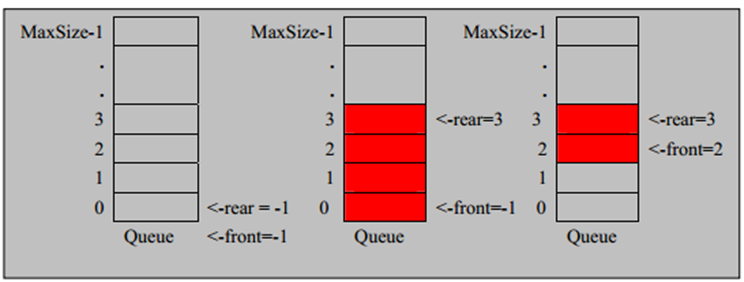队列介绍
- 队列是一个有序列表,可以用数组或是链表来实现。
- 遵循先入先出的原则。即:先存入队列的数据,要先取出。后存入的要后取出
数组模拟队列
数组模拟队列思路
- 队列本身是有序列表,若使用数组的结构来存储队列的数据,则队列数组的声明如下图,其中maxSize 是该队列的最大容量。
- 因为队列的输出、输入是分别从前后端来处理,因此需要两个变量 front 及 rear 分别记录队列前后端的下标,front 会随着数据输出而改变,而 rear 则是随着数据输入而改变,如图所示:

- 将数据存入队列时称为”addQueue”,addQueue 的处理需要有两个步骤:思路分析
1) 将尾指针往后移:rear+1,当 front == rear 【空】
2) 若尾指针 rear 小于队列的最大下标 maxSize-1,则将数据存入 rear 所指的数组元素中,否则无法存入数据。rear == maxSize - 1[队列满]
代码实现
import java.util.Scanner;public class ArrayQueueDemo {public static void main(String[] args) {//创建一个队列ArrayQueue queue = new ArrayQueue(3);char key = ' '; //接收用户输入Scanner scanner = new Scanner(System.in);//boolean loop = true;//输出一个菜单while(loop) {System.out.println("s(show): 显示队列");System.out.println("e(exit): 退出程序");System.out.println("a(add): 添加数据到队列");System.out.println("g(get): 从队列取出数据");System.out.println("h(head): 查看队列头的数据");key = scanner.next().charAt(0);//接收一个字符switch (key) {case 's':queue.showQueue();break;case 'a':System.out.println("输出一个数");int value = scanner.nextInt();queue.addQueue(value);break;case 'g': //取出数据try {int res = queue.getQueue();System.out.printf("取出的数据是%d\n", res);} catch (Exception e) {// TODO: handle exceptionSystem.out.println(e.getMessage());}break;case 'h': //查看队列头的数据try {int res = queue.headQueue();System.out.printf("队列头的数据是%d\n", res);} catch (Exception e) {// TODO: handle exceptionSystem.out.println(e.getMessage());}break;case 'e': //退出scanner.close();loop = false;break;default:break;}}System.out.println("程序退出~~");}}// 使用数组模拟队列-编写一个ArrayQueue类class ArrayQueue {private int maxSize; // 表示数组的最大容量private int front; // 队列头private int rear; // 队列尾private int[] arr; // 该数据用于存放数据, 模拟队列// 创建队列的构造器public ArrayQueue(int arrMaxSize) {maxSize = arrMaxSize;arr = new int[maxSize];front = -1; // 指向队列头部,分析出front是指向队列头的前一个位置.rear = -1; // 指向队列尾,指向队列尾的数据(即就是队列最后一个数据)}// 判断队列是否满public boolean isFull() {return rear == maxSize - 1;}// 判断队列是否为空public boolean isEmpty() {return rear == front;}// 添加数据到队列public void addQueue(int n) {// 判断队列是否满if (isFull()) {System.out.println("队列满,不能加入数据~");return;}rear++; // 让rear 后移arr[rear] = n;}// 获取队列的数据, 出队列public int getQueue() {// 判断队列是否空if (isEmpty()) {// 通过抛出异常throw new RuntimeException("队列空,不能取数据");}front++; // front后移return arr[front];}// 显示队列的所有数据public void showQueue() {// 遍历if (isEmpty()) {System.out.println("队列空的,没有数据~~");return;}for (int i = 0; i < arr.length; i++) {System.out.printf("arr[%d]=%d\n", i, arr[i]);}}// 显示队列的头数据, 注意不是取出数据public int headQueue() {// 判断if (isEmpty()) {throw new RuntimeException("队列空的,没有数据~~");}return arr[front + 1];}}
数组模拟环形队列实现
对数组模拟队列的优化,充分利用数组。因此将数组看做是一个环形的。(通过取模的方式来实现即可)
数组模拟环形队列思路
- 尾索引的下一个为头索引时表示队列满,即将队列容量空出一个作为约定,这个在做判断队列满的时候需要注意
(rear + 1) % maxSize == front满] rear == front[空]
算法思路:
- front变量的含义做一个调整: front 就指向队列的第一个元素,也就是说 arr[front] 就是队列的第一个元素 front 的初始值 = 0
- rear 变量的含义做一个调整:rear指向队列的最后一个元素的后一个位置。因为希望空出一个空间做为约定。rear 的初始值 = 0
- 当队列满时,条件是
(rear + 1) % maxSize == front【满】 - 队列为空的条件,
rear == front空 - 当这样分析,队列中有效的数据的个数
(rear + maxSize - front) % maxSize// rear = 1 front = 0 -
代码实现
```java public class CircleArrayQueueDemo {
public static void main(String[] args) {
System.out.println("测试数组模拟环形队列的案例~~~");// 创建一个环形队列CircleArray queue = new CircleArray(4); //说明设置4, 其队列的有效数据最大是3char key = ' '; // 接收用户输入Scanner scanner = new Scanner(System.in);//boolean loop = true;// 输出一个菜单while (loop) {System.out.println("s(show): 显示队列");System.out.println("e(exit): 退出程序");System.out.println("a(add): 添加数据到队列");System.out.println("g(get): 从队列取出数据");System.out.println("h(head): 查看队列头的数据");key = scanner.next().charAt(0);// 接收一个字符switch (key) {case 's':queue.showQueue();break;case 'a':System.out.println("输出一个数");int value = scanner.nextInt();queue.addQueue(value);break;case 'g': // 取出数据try {int res = queue.getQueue();System.out.printf("取出的数据是%d\n", res);} catch (Exception e) {// TODO: handle exceptionSystem.out.println(e.getMessage());}break;case 'h': // 查看队列头的数据try {int res = queue.headQueue();System.out.printf("队列头的数据是%d\n", res);} catch (Exception e) {// TODO: handle exceptionSystem.out.println(e.getMessage());}break;case 'e': // 退出scanner.close();loop = false;break;default:break;}}System.out.println("程序退出~~");
}
}
class CircleArray { private int maxSize; // 表示数组的最大容量 //front 变量的含义做一个调整: front 就指向队列的第一个元素, 也就是说 arr[front] 就是队列的第一个元素 //front 的初始值 = 0 private int front; //rear 变量的含义做一个调整:rear 指向队列的最后一个元素的后一个位置. 因为希望空出一个空间做为约定. //rear 的初始值 = 0 private int rear; // 队列尾 private int[] arr; // 该数据用于存放数据, 模拟队列
public CircleArray(int arrMaxSize) {
maxSize = arrMaxSize;
arr = new int[maxSize];
}
// 判断队列是否满
public boolean isFull() {
return (rear + 1) % maxSize == front;
}
// 判断队列是否为空
public boolean isEmpty() {
return rear == front;
}
// 添加数据到队列
public void addQueue(int n) {
// 判断队列是否满
if (isFull()) {
System.out.println("队列满,不能加入数据~");
return;
}
//直接将数据加入
arr[rear] = n;
//将 rear 后移, 这里必须考虑取模
rear = (rear + 1) % maxSize;
}
// 获取队列的数据, 出队列
public int getQueue() {
// 判断队列是否空
if (isEmpty()) {
// 通过抛出异常
throw new RuntimeException("队列空,不能取数据");
}
// 这里需要分析出 front是指向队列的第一个元素
// 1. 先把 front 对应的值保留到一个临时变量
// 2. 将 front 后移, 考虑取模
// 3. 将临时保存的变量返回
int value = arr[front];
front = (front + 1) % maxSize;
return value;
}
// 显示队列的所有数据
public void showQueue() {
// 遍历
if (isEmpty()) {
System.out.println("队列空的,没有数据~~");
return;
}
// 思路:从front开始遍历,遍历多少个元素
// 动脑筋
for (int i = front; i < front + size() ; i++) {
System.out.printf("arr[%d]=%d\n", i % maxSize, arr[i % maxSize]);
}
}
// 求出当前队列有效数据的个数
public int size() {
// rear = 2
// front = 1
// maxSize = 3
return (rear + maxSize - front) % maxSize;
}
// 显示队列的头数据, 注意不是取出数据
public int headQueue() {
// 判断
if (isEmpty()) {
throw new RuntimeException("队列空的,没有数据~~");
}
return arr[front];
}
} ```


